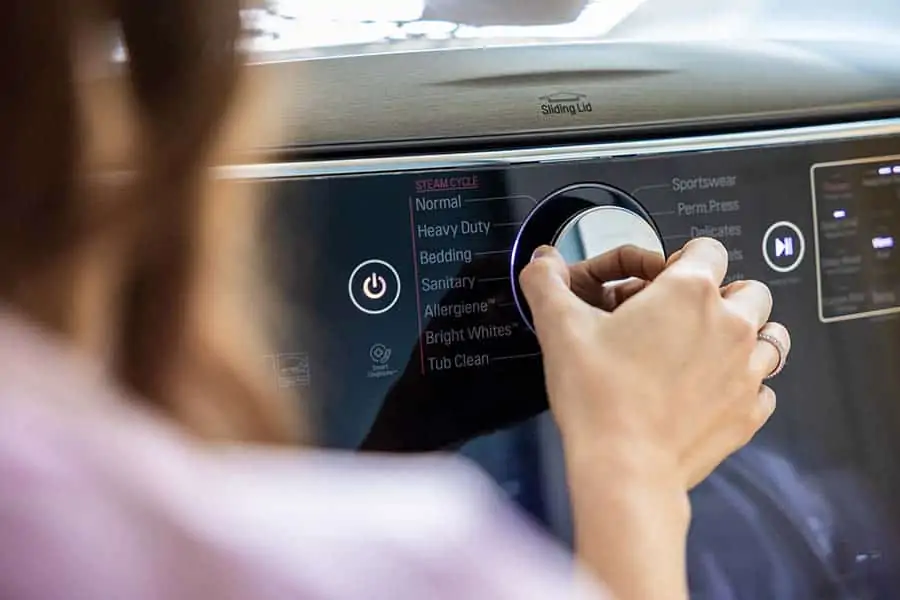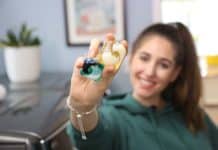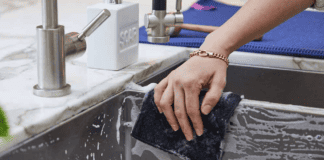2010 was the first time we in North America saw the modern-day laundry detergent packs (also referred to as packets, pods, paks, pacs) come on the market. They looked cute and colorful, and we were told they’d make doing laundry easier. But they were, perhaps, a little confusing.
Have you actually tried a laundry pack (i.e., Tide Pods)? I hadn’t until, well, February of 2022, so 12 years after they came on the scene. I know many people are hesitant about packs, the same way we were all hesitant about switching from powdered laundry detergent to liquid detergent back in the 80s. In fact, I didn’t switch to using liquid laundry detergent until 2007, when I moved out of my mom’s house and into a condo.
Powder dissolved really well in hot water, and many of us remember using hot water and powdered detergent when we all had top-loading machines with a central agitator column. When cold water washing to help reduce energy consumption became trendy, many of us didn’t trust powder to dissolve well, which is why we transitioned to liquid (which was pre-dissolved yet powerful). Further, with the advent of front loader high efficiency (HE) washing machines that use less water, liquid was all but a must. Then, packs came along. Let’s talk about why.

Laundry Packs: Everything You Need to Know
In the laundry space, there are several challenges with detergents that packs set out to solve. First: the mess. Detergent can get messy when being measured and dosed out. Second: dosing. Dosing is always a challenge for consumers. There are so many questions like: how much detergent should we use and what if the machine is high efficiency?
There are reasons to add more detergent, like if the load contains heavily soiled items or we have a large load of laundry to do. But, if we overdose the detergent, soap residue can be left behind. And if we don’t add enough detergent, dirt and soil will remain on the clothing. So how much detergent should you use? It can be anyone’s guess!
Finally: additional laundry products. A lot of additional products have to be added to the wash to accomplish effective soil, stain, and odor removal.
When we look at a pack, it comprises a fully dissolvable film and gives the detergent company the ability to both adequately dose product as well as, for more advanced formulations, separate the chemistry involved in a laundry detergent that would otherwise lose its properties when mixed together in a homogeneous liquid. Further, they take the guesswork out of dosing, allow for more concentrated formulas and less water use, and finally, keep detergent off busy hands. I.e., they solve all the laundry challenges for us!

Laundry Pack Ingredients
I recently learned what’s in a laundry pack, and it’s pretty amazing. Laundry packs contain surfactants, enzymes, polymers, antioxidants, builders and chelants, and metals and minerals. Now you’re probably saying, what the heck does this mean? Let me explain.
Surfactants help clean dirt and soils while enzymes break down stains and dirt into smaller particles and bring them to the surface of a fabric. Polymers act to suspend dirt in water which prevents it from redepositing it back onto the fabric, while antioxidants stop the oxidation of body soils from breaking down and turning into bad smells. Builders and chelants purify the wash water from chlorine, and metals and minerals help protect fabrics and make it easier for other technologies to clean (this is important, especially if you have hard water).
Basically, all the ingredients in a laundry pack like a Tide Pod work together to remove dirt and soil, even on heavily soiled items, while preventing oxidation from creating bad smells and protect our garments by purifying the wash water. And what’s even more amazing is the chambers of packs allow for these different components to be separated out and activated upon dissolution. We couldn’t get that kind of technology before with liquid or powder detergent, and that’s pretty cool!
Now that we’ve covered some science behind the packs, let’s talk about how to use them and some common questions and concerns.
How Do You Use Laundry Packs?
Place at the bottom and back of your wash drum if you have a front-load, and at the bottom of your washer if you have a top load. You want them as close to the water as possible so they can be activated right away.
Some machines are even being built with pack chutes where the detergent trays are, which then add water and activate the packs immediately. Check if your machine has this option.
How Do You Dose Laundry Packs?
As always, follow the instructions on the package. The company knows best since some packs are larger or more concentrated. Generally speaking, a small load (i.e. roughly one small laundry basket full of clothing, NOT brimming over) is about eight pounds and can use one pack.
Think about it like this: as laundry machines get larger and take on more capacity, that same eight-pound load can look a lot smaller in the bigger machine…but it still has the same amount of soil and “cleaning needs.” So, if we have a larger load going into a larger machine, it makes sense we would add two packs to handle the additional soils, stains, and odors.
For even more laundry, say three of those small baskets, or for heavily soiled garments (say you’re cleaning clothing used for camping, gardening, or cleaning the garage), you’d want to use three packs.

What if a Laundry Pack Doesn’t Fully Dissolve?
If you open your washer to find your pack didn’t fully dissolve (maybe it’s even partially stuck on a garment!), this means you added the pack to the wrong spot in your washer.
First of all, your load may not have gotten as clean as you’d like it to, and you may want to re-wash. If a pack is stuck on an item of clothing, simply run it under cold water.
Second of all, next time you do a load of laundry, ensure you add your pack to the correct place in your washing machine.
What Is The Outside of a Laundry Pack Made Of?
Packs are made of a completely water-soluble film that is used across the cleaning industry and has been well researched and tested for safe use in the home as well as for its ability to completely biodegrade safely. The material used is PVOH or polyvinyl alcohol.
While I thought these were plant-based, actually, many are still petroleum-based. There is currently research going into plant-based films; however the cost to use plant-based films is still too high for them to be feasible for the average laundry detergent company.
What Happens to a Laundry Pack?
The pack dissolves and rinses away with the wash water. It flows into the water treatment plant, and microbes and bacteria feast on the material. When it flows back into the water system, additional bacteria and microbes break remnants down using natural biodegradation.
According to studies, at least 60% of the laundry pack’s film is biodegraded 28 days after the laundry cycle. And modeling shows 100% is biodegraded within 90 days or less.

Do Laundry Packs Contain Microplastics?
First, let’s define microplastics. According to the ACI, “Microplastics are microscopic solid particles made of synthetic polymer that are insoluble in water and typically resistant to biodegradation in the aquatic environment. Although our understanding of microplastics is evolving, California’s proposed definition refers to particles that are solid (i.e., not water-soluble) polymeric materials that have at least two dimensions greater than 1 but less than 5,000 micrometers (µm). Such plastics may be intentionally added (such as microbeads), or result from progressive physical fragmentation of plastic objects into smaller and smaller particles that can take place in the environment. Such particles can be ingested and potentially transfer within food chains. Further, microplastics are practically impossible to remove from the environment after release.”
Now that we have a clear definition of microplastic, we can better understand the difference between microplastic and PVOH. The ACI goes on to say, “Although PVA films have similar properties to many plastics such as flexibility, they fully dissolve in water when used, and the dissolved polymers are fully biodegraded by microorganisms in water treatment facilities and the environment. Whereas microplastics are persistent in the environment and do not biodegrade.”
Remember, not all packs are created equal, and better quality detergents will get you more technology and help to maximize your laundry efforts.
Laundry Packs Are Your New Best Friend
Now you are pack-ucated. And you can quote me on that! So, should you use laundry packs? From what I’ve seen, I get a better clean using a pack than I do with liquid! They are way easier to dose, mess-free, and they’re not hard on the environment. Plus, with ongoing technology packs will get more and more environmentally friendly.
This is our official announcement that the CMS HG is going to be making the switch to laundry packs! So, when my current laundry detergent is almost finished, I’ll reserve it for stain removal, and I can’t wait.
Let me know in the comments if you’ll be trying packs, you already use packs, or you’re sticking with laundry detergent!
Looking for a BETTER & EASIER Way to Clean Your Home?
Cleaning Expert Melissa Maker is here to help with her game-changing 3 Wave Cleaning System that will help you clean your house faster and easier than you ever thought possible!

















Hello, do you use a different Landry pod for your microfiber clothes. One without oxygen bleach or fragrance?
Do you find the generic or store brand pods do as well as the big name brand pods?
If you’re using a laundry pack, are you still using vinegar in the wash also?
Hi Melanie, I don’t use vinegar in every load of laundry (just the stinky ones, towels, etc.) but you can absolutely use vinegar if you are using a laundry pack 🙂